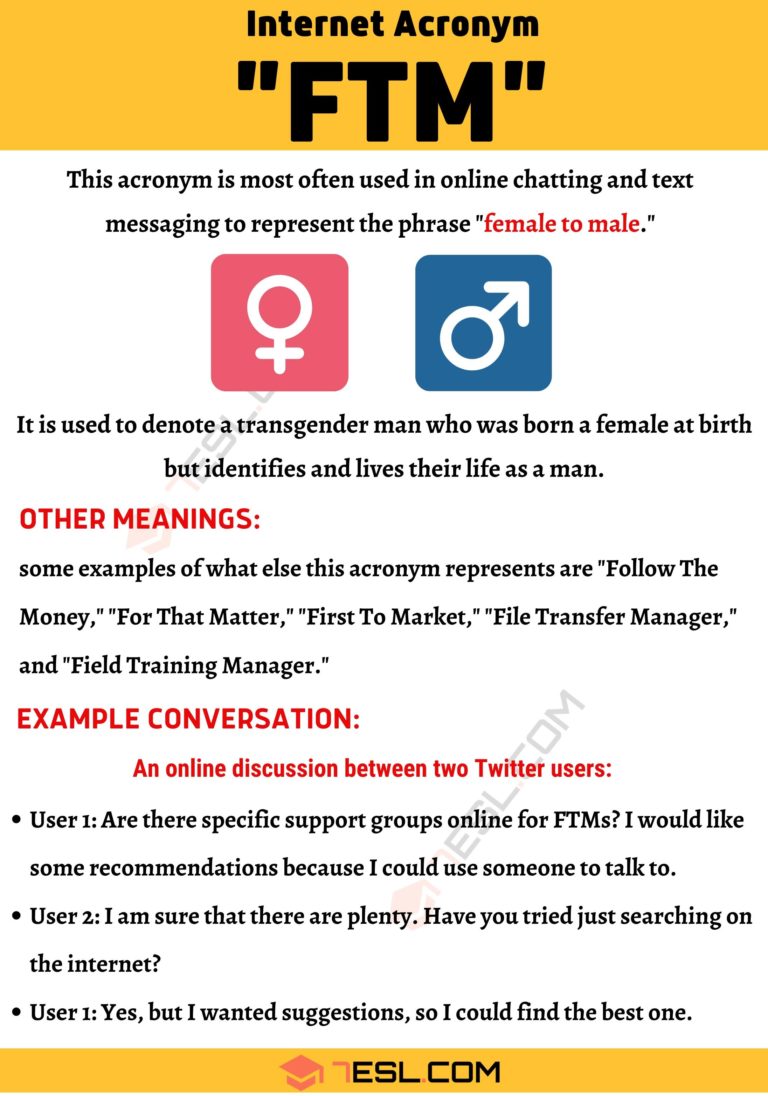Decoding FTM: Meaning, Usage, And Common Misconceptions

Decoding FTM: Meaning, Usage, And Common Misconceptions. Discover more detailed and exciting information on our website. Click the link below to start your adventure: Visit Best Website. Don't miss out!
Table of Contents
Decoding FTM: Meaning, Usage, and Common Misconceptions
Understanding the complexities of FTM and its impact on society.
The acronym FTM, standing for Female-to-Male, is frequently encountered in discussions surrounding gender identity and transgender experiences. However, the true meaning and nuances of FTM often remain misunderstood. This article aims to clarify the term, explore its usage in various contexts, and address prevalent misconceptions surrounding female-to-male transgender individuals. We'll delve into the complexities of FTM identities, experiences, and the importance of respectful and accurate language.
What Does FTM Mean?
FTM is an abbreviation referring to individuals who were assigned female at birth but identify as male. It's a crucial term within the transgender community, acknowledging the individual's internal sense of gender, which differs from the sex assigned at birth. This internal sense of gender is deeply personal and fundamental to an individual's identity. It's important to remember that FTM is an umbrella term encompassing a diverse range of experiences. There's no single FTM experience; each individual's journey is unique and shaped by personal factors, cultural contexts, and social support.
How is FTM Used?
The term FTM is primarily used within the context of:
- Medical discussions: FTM individuals may use this term when interacting with healthcare providers concerning hormone replacement therapy (HRT), surgical options (such as top surgery or bottom surgery), or other medical care specific to their transition.
- Legal documents: In some cases, FTM may be used in legal contexts to clarify gender identity for official documentation, such as driver's licenses or passports.
- Community and support groups: The term serves as a valuable identifier within the transgender community, fostering connection and support among individuals sharing similar experiences.
- Academic and research settings: Studies on transgender health and social issues frequently use the acronym FTM for data categorization and analysis.
Common Misconceptions About FTM Individuals
Several misconceptions unfortunately surround FTM individuals. It's crucial to address these inaccuracies to promote understanding and acceptance.
- Misconception 1: All FTM individuals undergo surgery. This is false. Many FTM individuals choose not to undergo any surgeries as part of their transition, while others may opt for some procedures but not others. Transition is a deeply personal journey with a wide spectrum of choices.
- Misconception 2: FTM individuals are all the same. The experiences and expressions of FTM individuals are diverse and multifaceted. There's no single "FTM experience." Ignoring this diversity reinforces harmful stereotypes.
- Misconception 3: Gender identity is a choice. Gender identity is not a choice, but rather an inherent aspect of a person's identity. It's crucial to understand and respect the validity of each individual's gender identity.
- Misconception 4: Using correct pronouns is too difficult. Using correct pronouns is a matter of respect and demonstrates basic human decency. It's a simple yet powerful way to show support and affirmation.
The Importance of Respectful Language and Terminology
Using accurate and respectful language is paramount when discussing FTM individuals and the transgender community. Instead of using outdated or offensive terms, opt for respectful language that reflects each individual's self-identified gender. Always use the individual's preferred name and pronouns. This simple act demonstrates acceptance and validation.
Moving Forward: Fostering Understanding and Acceptance
Understanding FTM experiences is crucial for building a more inclusive and accepting society. By challenging misconceptions, using inclusive language, and actively listening to the voices of FTM individuals, we can create a more supportive and affirming environment for everyone. Learn more about LGBTQ+ issues and resources by visiting [insert link to relevant resource here]. Let’s work together to promote understanding and acceptance.

Thank you for visiting our website wich cover about Decoding FTM: Meaning, Usage, And Common Misconceptions. We hope the information provided has been useful to you. Feel free to contact us if you have any questions or need further assistance. See you next time and dont miss to bookmark.
Featured Posts
-
 Ann Arbors The Ride A Moving Tribute To Rosa Parks
Feb 05, 2025
Ann Arbors The Ride A Moving Tribute To Rosa Parks
Feb 05, 2025 -
 Neige Et Verglas Perturbations Importantes En Plaine
Feb 05, 2025
Neige Et Verglas Perturbations Importantes En Plaine
Feb 05, 2025 -
 Understanding And Fixing Overflow Issues In Web Design
Feb 05, 2025
Understanding And Fixing Overflow Issues In Web Design
Feb 05, 2025 -
 Understanding Sfw What It Means And Why It Matters Online
Feb 05, 2025
Understanding Sfw What It Means And Why It Matters Online
Feb 05, 2025 -
 Meurtre A Livry Gargan Un Homme Poignarde En Pleine Rue
Feb 05, 2025
Meurtre A Livry Gargan Un Homme Poignarde En Pleine Rue
Feb 05, 2025
